As we said in the last post, from 0400 Saturday on, the seas had no wind waves, with only two to four foot, gentle, widely spread apart swells. The wind was almost non-existent at 0 – 3 knots real. The calm wind conditions lasted all night, as well.
During the night watch we had three strange sightings. A target would pop up in the middle of the screen, near our position, stay on the screen about a half hour, then vanish again. When we looked outside, even with the spotlight, we couldn’t see any of them. One time we had to change course to avoid the target. Eric thinks they are all buoys, maybe even fishing nets attached to buoys.
Thanks to the calm seas, we were making great time and had to slow down. San Francisco Bay has strong currents and we needed to time our entry carefully to be at slack tide changing towards flood tide so when the tide did come in, it would be with us.
By 1130, we were at the first marker for San Francisco Bay. Almost about the same time we passed the buoy, the fog picked up, though we still had three mile visibility. We entered the channel into San Francisco Bay at 1230, traveling just south of the shipping lane. Traffic was light; only a couple other vessels were heading in and none heading out.
We were amazed by how large the breaking waves were on the north side of the bay. Today was a relatively calm day; they must be unbelievable on days where the waves are bigger. Inside the bay, the swell died down, but it got significantly choppier.
At 1300, the Golden Gatebridge became slightly visible in the fog. A handful of boats, mostly tourist boats, were in the bay west of the bridge. Here is a shot of the bridge as we neared it.
We passed under the Golden GateBridgeat 1345. Here is a shot going under and one looking back at it.
Apparently, the bridge must be a magic dividing line; on the east side there were boats galore. The current was strong, pushing us along at 8.5 knots—at one point we even briefly got up to 9!
Here are a couple shots: the first is downtown San Francisco and the second is the Bay Bridge:
As we neared the Bay Bridge, the sun came out and the wind started to pick up. Fortunately, the marina was near the bridge, so we were able to get into our slip and tied up before the wind got too strong. The marina is near the baseball park, and as Christi jumped onto the docks, she could hear cheering from the stadium. A game was in session!
After checking in with the marina office, we ventured out in search of food. The game must have just let out, because enormous crowds of people were marching down the street. Feeling tired from the passage and not wanting to fight off the crowd, we picked a place next to the marina with only okay food.
The slip we are in is near the marina entrance and is both rocky and surgy. Eric spent considerable effort adjusting and re-adjusting the lines. The wind got up to 20 knots, and it was just as windy when we went to bed at 2000 (after a passage, we always go to bed early!). In San Diego, the wind normally died after sunset.
We are thrilled to finally be using Kosmos as a boat again, not as a floating condo. The wonderfully smooth conditions added to the elation about being on the go again. Since returning home from our circumnavigation, we’ve only done day hops. The Ventura leg was the first overnight passage we’ve done in over two years, and this Ventura to San Francisco leg is the first multi-day passage. We found it interesting that we so easily fell back into our “at sea routine.” Yes, we were rusty on a couple things at first, but it wasn’t long before it all came back.
We thought that after so long, we would have lost all our tolerance to the seas. We probably have lost most of it, but when we rounded Point Conception neither of us got sick, which showed that we have some residual tolerance left. When we first bought Kosmos, while doing a practice run, we both got sick in seas that were not nearly as rough.
Sticking to this week’s theme of stuff we’ve done to Kosmos…One of the interesting things was change out about 2/3 of the interior light bulbs to LED, as well as all the navigation lights. The LEDs use 80 – 90% less power than the existing halogen bulbs did; a huge power savings! They also are cool to the touch, so we never have to worry about burning ourselves by touching a hot light fixture (it was rare, but it has happened!). The LED bulbs fit in the existing fixtures, so no need to upgrade to special LED fixtures. The LED bulbs have come a long way in terms of brightness and color. The light isn’t quite the same color as our other bulbs, but they are as bright or brighter.
We tried to go LED five years ago. Back then, the technology was newer and the bulbs weren’t all that bright and kind of a funny color, so we changed out less than half in each room to keep the room from being too dim. The bulbs were defective. After only a few months, one by one, they started blinking like disco balls for a couple weeks, then went dead. We’re hoping this experience is better!
This year we also changed all the house batteries out (and were pleased with the company that did the work). If you baby your batteries, they can last more than five years, but we were hard on ours so they only lasted five. We mentioned in a post a couple years back that shortly after completing the circumnavigation, we installed a smaller group 31 starter battery. At the time, we didn’t think a large 4D battery was necessary, but after finding out it also connected to the stabilizers, we realized that the 4D was the probably a better choice. When we changed out the house bank, we moved the group 31 to the generator/wing engine and put in a new 4D as the starter battery.
This is part 3 of an 11 part series on our time in San Francisco. Read part 2 here and part 4 here.

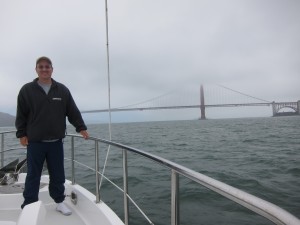
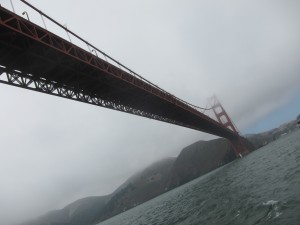
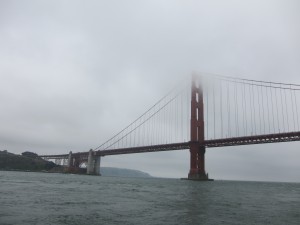
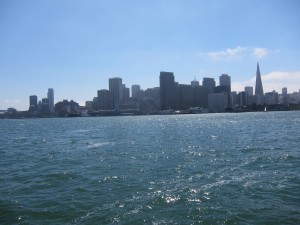
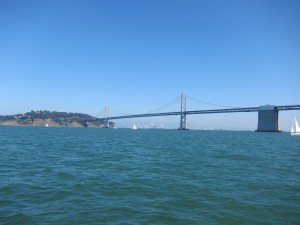
Hey guys,
You made it to our back yard of SF. Where are you? No updates for 2 weeks?
What are your next plans from here out? Are you guys heading to alaska?
Chances are we’ll probably go back to San Diego in a few months.
We’re in a very rolly marina in downtown SF, but we may be moving marinas soon because I can’t take being on the boat all day with so much motion. The afternoons are particularly bad–its like being at sea! Eric is working and I am still trying to get book 2 done, the workbook done, and take care of “life chores,’ so we have not had much time for sightseeing. Since my writing time is limited, I always have to choose between the books and blog posts… the books usually win. But, book 2 is in the home stretch. The editor is 3/4 done.
Saw your beautiful boat yesterday in Oakland near London Square. Enjoy!
Hello Kosmos from Hale Kai (N4302). We are in the process of going LED and are comparing light output. I’m interested in what LED’s (type and vendor) you are happy with?
Thanks. Larry
We replaced most of the interior bulbs onboard with Imtra bulbs. We tried several bulbs that didn’t fit properly and wound up with Imtra because they fit just right. We bought them from Daily Marine WaterMaker Store, http://www.seatechmarineproducts.com/. Since we bought so many, we got them for $15 per bulb instead of $20. We didn’t change the courtesy lights or wall mounted reading lights, but we did change the interior overhead reading lights. We also used the Imtra lights in the cockpit (exterior). So far they have worked great. As for quality of light, they are pretty good. If you like lower lighting, they are great. If you like brighter lights, they aren’t so bright. But the color the light gives off is good. The first time we tried interior LED, the color of the light was weird and they were really dim.
For the exterior nav lights we used LunaSea bulbs that we bought at San Diego Marine Exchange http://www.downwindmarine.com/downloads/StoresContactInfo.html
One of the LunaSea bulbs has gone bad. We are happy with the brightness of the bulbs and the color the light gives off. We thought the incandescent bulbs that we had prior were actually too bright.